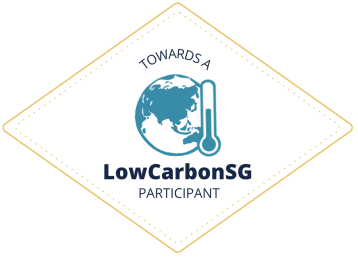Carbon Accounting and GHG Management
This programme provides participants with essential skills to measure, report, and manage greenhouse gas emissions, supporting organizations in achieving their carbon reduction and sustainability goals.

The shift to a low-carbon economy is not just the future—it’s happening now. Equip your business with the tools to measure, monitor, and reduce your emissions with LowCarbonSG, and stay ahead of the curve.
LowCarbonSG is a capability-building programme designed to empower local businesses to take control of their carbon emissions. Through this programme, companies can expect to gain the knowledge and resources needed to track, manage, and actively reduce their carbon footprint.
Businesses that successfully complete the programme and meet the criteria will be awarded the prestigious LowCarbonSG Participant Logo—signifying their commitment to sustainability and leadership in decarbonisation.
Led by CPLC Singapore, the decarbonisation arm of GCNS, and supported by the NEA and Enterprise Singapore, LowCarbonSG is the definitive step towards building a resilient, future-ready business in a low-carbon world.

Receive personalised support from CPLC Singapore to complete CERT and connect with solution providers to help implement sustainable practices and reduce emissions effectively.

Showcase your commitment to decarbonisation with recognition on the LowCarbonSG website. Leverage the LowCarbonSG Participant Logo to communicate your business’s progress in reducing its carbon footprint.

Gain access to the Carbon and Emissions Recording Tool (CERT) and participate in carbon management workshops led by CPLC Singapore. Additionally, utilise an accompanying playbook on carbon management and stay informed about government grants to support the adoption of sustainable solutions.
Complete the LowCarbonSG pledge and the CPLC Singapore partner pledge form. Being a CPLC Singapore Partner is complimentary.
Attend either a 1-day carbon workshop or 2-day carbon course, where you will learn how to use the Carbon & Emissions Recording Tool (CERT) to measure and monitor carbon emissions.
After attending the above course, your company will be provided access to CERT to get started on tracking your emissions.
Complete and submit CERT to CPLC Singapore at required intervals.
Reduce emissions where possible, and agree to share one’s success story as a case study.
Check out the various dates of our courses here.
For any queries, please reach out to our CPLC Team.
Your company can begin tracking its emissions using CPLC Singapore’s Carbon and Emissions Recording Tool (CERT). Developed with input from the National Environment Agency (NEA), CERT features inbuilt formulas that enable companies to easily calculate their emissions based on energy consumption, waste generation, and transportation data.
To qualify for the LowCarbonSG Participant Logo, companies must attend either a 1-day carbon workshop or a 2-day carbon course to build the necessary capabilities for submitting CERT at the required intervals. For the first submission, companies will establish a 12-month emissions baseline using historical data. Once the data input is validated by the CPLC Singapore team, the company will be awarded the LowCarbonSG Participant Logo.
Over the next 12 months, companies are expected to monitor their emissions and are encouraged to take steps to reduce them. Companies that continue to measure and report their emissions may continue using the Participant Logo.
At the end of the 24-month period, companies will submit a second set of data covering the past 12 months. After validation, they will receive an updated Participant Logo reflecting the year of submission. Companies that have successfully reduced their emissions will be eligible for consideration for the prestigious LowCarbonSG Awards.
To demonstrate an ongoing commitment to sustainability, companies are encouraged to make annual submissions to receive updated logos each year.
To obtain the LowCarbonSG Participant Logo, a company must consistently track its carbon emissions using CERT. Once the data entered in CERT has been validated, the company will be awarded the LowCarbonSG Participant Logo in recognition of its efforts to build a habit of emissions-consciousness.
CERT is user-friendly and requires readily available data, typically found in documents such as electricity bills and fuel invoices. With these documents on hand, completing CERT should take no more than one to two hours each month.
If your company needs support, you can reach out to the CPLC Singapore team for assistance. The CPLC Singapore team also conducts regular carbon management workshops to help companies use CERT effectively.
LowCarbonSG is an inclusive programme that welcomes all companies registered in Singapore, especially those taking their first steps in decarbonisation.
The Carbon & Emissions Recording Tool (CERT) is a robust tool designed to help companies of varying sizes and sectors track their Scopes 1, 2 and 3 emissions with ease.
Beyond tracking emissions, your company is highly encouraged to take active steps to reduce them. Companies that successfully achieve emissions reductions will be eligible for consideration for the prestigious LowCarbonSG Awards. In addition, success stories may be featured in our publications, including the annual Carbon Report.
After graduating from LowCarbonSG, your company is encouraged to continue tracking emissions and actively seek opportunities for further reduction. We also recommend advancing to more comprehensive carbon footprint reporting and adopting ambitious sustainability targets, such as Science-Based Targets (SBTs).
Our Carbon & Emissions Recording Tool (CERT) aligns with international standards like the Greenhouse Gas Protocol, making it ideal for companies taking their first steps in their decarbonization journey. Through the LowCarbonSG programme, your company will gain essential insights into carbon reporting, easing the transition toward more advanced sustainability frameworks.